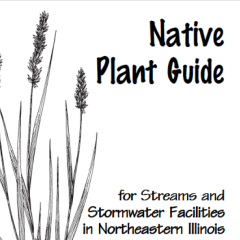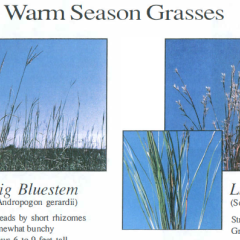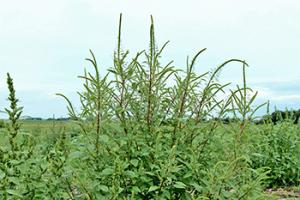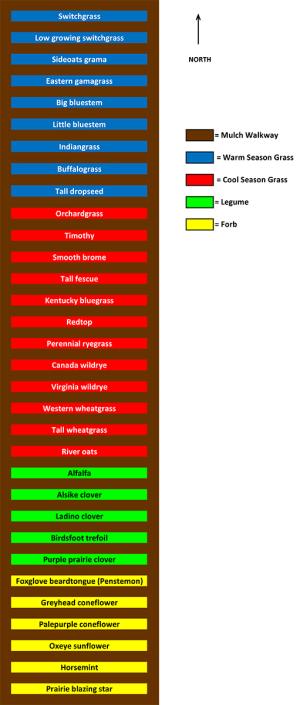Illinois Native Plant Guide
This 180 page guide to Illinois Native Plants has everything you need for native plants with topics such as native plant applications, species, and even a list of vendors and prescribed burn contractors.

Conservation Plants-Pocket ID Guide
This printable reference guide can help you identify plants important to conservation in the field.

Native Plants: Warm-Season Grasses, Flowers, and Legumes
Interested in seeing Illinois native plants, warm-season grasses, flowers, legumes, and forbs that will thrive in Illinois? Check out this factsheet with color photos to help you identify species and learn what planting and site conditions they prefer.

Invasive Species
National Invasive Species Council
Palmer amaranth
Palmer amaranth (Amaranthus palmeri) is a problematic annual broadleaf weed in the amaranth genus. It has several common names including carelessweed, dioecious amaranth, Palmer’s amaranth, Palmer amaranth and Palmer’s pigweed.

Palmer amaranth (Amaranthus palmeri) is an adaptable and invasive weed found in several Illinois counties since 2012. The plant can be introduced to farm fields through contaminated cattle feed, manure, birds, hay or mulch, equipment or vehicles not properly cleaned. During the 2016 growing season, Palmer amaranth was found on some land enrolled in USDA programs, like the Conservation Reserve Program (CRP). In a few cases, Palmer amaranth was found in seed purchased for the pollinator and other wildlife plantings. Individuals obtaining seed for pollinator plantings need to ensure the seed they purchase contains no Palmer amaranth seeds. Palmer amaranth is considered a serious pest that poses a potential threat to annual crops in Illinois.
NRCS is working closely with the Farm Services Agency (FSA) to help farmers and landowners address this invading weed on land in the Conservation Reserve Program (CRP) and other land. A document with Illinois-specific guidance and resources are available to help farmers identify if this exact species is on their farm fields, to successfully eradicate (kill) plants found on the farm, and to carefully control the spread of this species or its seed.
Successful eradication/elimination of Palmer Amaranth can be accomplished using:
- Mowing
- Hand-pulling
- Spot herbicide treatment
- Flame weeding
- Broadcast herbicide (pre/post)
- Broadcast non-selective herbicide
Palmer amaranth Facts
- Palmer amaranth is an annual weed that is fast growing (possibly more than 3 inches per day), can grow to more than 6 feet tall, and produces many small viable seeds (100,000–500,000 seeds). Seed can remain dormant in the soils and germinate years later.
- Palmer amaranth has the potential to spread to agricultural fields, can be very difficult to control, can significantly increase production costs, and may reduce crop yields due to competition. Additional conservation practices, such as Conservation Crop Rotation, Integrated Pest Management, Residue and Tillage Management, No-Till or Reduced Till, and Cover Crops, may be used if found in crop fields. Fast-growing cover crops and those with allelopathic qualities (the release of chemicals by one plant that inhibits the growth of adjacent plants) should be considered.
- Identification of Palmer amaranth should be done with assistance of your State department of agriculture and land grant university extension specialists. Program participants are responsible for contacting these agencies for assistance.
- Palmer amaranth can develop resistance to herbicides, such as glyphosate and acetolactate synthase-inhibiting herbicides (ALS).
- The landowner, operator, or program participant should seek recommended control measures from State agricultural and extension specialists. NRCS will not develop chemical pest suppression recommendations, consistent with 190-GM, Part 404, “Pest Management.”
- A multi-pronged approach to address Palmer amaranth may include a combination of mowing during establishment before seed maturity, hand weeding, burning, and spraying. Mowing alone will not disrupt seed production.
- The presence of Palmer amaranth does not necessarily constitute a stand failure. Stand success or failure is determined by plant density. States will use their established stand establishment guides for determining stand success or failure. Successful stands with Palmer amaranth should also have it removed.
- After seed maturity, terminating the stand by tillage spreads and incorporates the mature seed, making it harder to achieve control in the future. Inverting the soil to bury the seed will leave the field susceptible to erosion and is not recommended by NRCS.
- Broadcast herbicide application on the entire field may not kill Palmer amaranth and, since the herbicide may kill all broadleaf species, the reduced competition from desirable plants allows the weed to further establish a monotypic stand. Desirable plants may need to be reestablished following appropriate program requirements.
- Sources of Palmer amaranth introductions may include cattle feed, manure, birds, hay or mulch, clothing, equipment or vehicles that have not been cleaned properly, or as a contaminant of native seed mixes purchased for conservation plantings.
- Program participants should purchase native seed from reputable sources. Land owners planning conservation seed mixes should seek relevant important information about what they are purchasing from their commercial source.
- Producers and landowners should look closely at the seed label, in particular the “weed seed” analysis. An “all State noxious weed seed” test may be useful for detecting species of concern which may not be on your State’s noxious weed seed list. Seed laboratory test results and information on weed seed content and species that may be present for each species in a mix may be obtained from the seller. A weed seed listing of “Amaranthus sp.” or “pigweed” may indicate a number of species in this genus. Palmer amaranth is difficult to distinguish from other Amaranthus species. A genetic test for Palmer amaranth seed has been recently validated and may be available in the coming months for additional testing when Amaranthus seed is detected in a seed test.
- Confidential and voluntary safe reporting is essential.
What You Need to Know
- Palmer amaranth is a weed that can significantly reduce crop yields and increase crop production costs.
- Palmer amaranth is a weed that can be difficult to control and can develop resistance to several commonly used herbicides.
- Besides the introduction through seed mixes, other sources of Palmer amaranth introduction may include contaminated cattle feed, manure, birds, hay or mulch, and equipment or vehicles which have not been properly cleaned.
- In the upper Midwestern states, Palmer amaranth cannot be readily identified in fields until late June or early July.
- Landowners and farmers should be proactive in identifying palmer amaranth on their property to prevent Palmer amaranth from reseeding. Landowners can actively search for it in crop fields, borders, ditches, conservation lands and around dairies.
Identifying Palmer Amaranth
- Bob Hartzler Described Palmer Amaranth
- Palmer Amaranth Biology, Identification, and Management
- Palmer Amaranth Identification Video
- Distinguishing Palmer Amaranth from Common Waterhemp
Plant Materials Garden

The USDA Natural Resources Conservation Service (NRCS) Plant Materials Garden is located in Champaign, Illinois between the entrance and exit ramps of I-72, just off Country Fair Road.
It has taken years to get the garden in the shape for training and observation purposes. The plants came from our Plant Materials Center in Elsberry, MO, and a local Boy Scout troop helped with the plantings.
We have 4 different type of species planted in the garden: warm season grasses, cool season grasses, forbs and legumes. These different species are used for a variety of different agricultural conservation activities. Some plants can also be used in your garden or lawn in urban settings.
Please feel free to come and visit our plant materials garden any time between 8:00 am and 4:30 pm. The garden is in the West Parking lot of the USDA-NRCS building.

Plant Materials Garden Plants and Descriptions
Forbs are broad-leaved herbaceous plants (as opposed to a grass), especially when growing in a field, prairie, or meadow.
Prairie Blazing Star (Liatris pynostachya)
Horsemint (Monardo fistulosa)
Oxeye False Sunflower (Heliopsis helianthoides)
Pale Purple Coneflower (Echinacea pallida)
Gray-headed Coneflower (Ratibida pinnata)
Foxglove Beardtongue (penstemon digitalis)
Legumes are a large family (Leguminosae syn. Fabaceae, the legume family) of dicotyledonous herbs, shrubs, and trees having fruits that are loments (typically found in pods), bearing nodules on the roots that contain nitrogen-fixing bacteria, and including important food and forage plants (as peas, beans, or clovers).
Purple Prairie Clover (Dalea purpurea)
Birdsfoot Trefoil (lotus corniculatus)
Ladino Clover (Trifolium repens)
Alsike Clover (Trifolium hybridum)
Alfalfa (Medicago sativa)
Cool Season Grasses green up and/or germinate under cooler soil and air temperatures and can usually remain actively growing through the occasional freezing temperatures fall and spring.
River Oats (Chasmanthium latifolium)
Tall Wheatgrass (Agropyron elongatum)
Western Wheatgrass (Agropyron smithii)
Virginia Wild Rye (Elymus virginicus)
Canada Wild rye (Elymus Canadensis)
Perennial Ryegrass (Lolium perenne)
Redtop (Agrostis gigantea)
Kentucky Bluegrass (Poa pratensis)
Tall Fescue (Festuca arundinacea)
Smooth Bromegrass (Bromus inermis)
Timothy (Phleum)
Orchardgrass (Dactylis glomerata)
Warm Season Grasses are generally categorized as species that excel during the hottest months and die or go dormant during cooler seasons.
Tall Dropseed (Sporobolous compositus)
Buffalograss (Bouteloua dactyloides)
Indiangrass (Sorghastrum nutans)
Little Bluestem (Schizachyrium scoparium)
Big Bluestem (Andropogon gerardii)
Eastern Gamagrass (Tripsacum dactyloides)
Sideoats Grama (Bouteloua curtipendula)
Low Growing Switchgrass (Panicum virgatum)
Switchgrass (Panicum virgatum)


